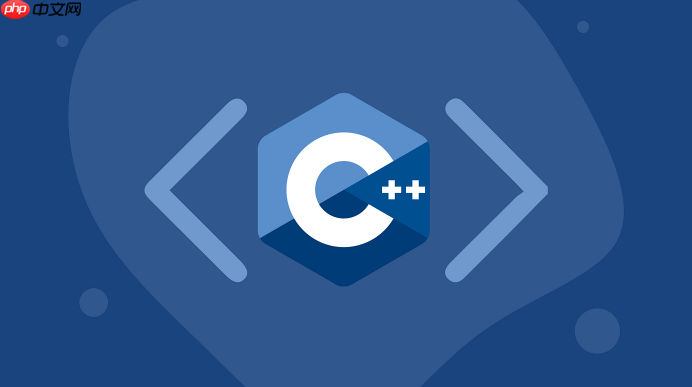C++中异常处理通过try-catch结构捕获并处理运行时错误,避免程序崩溃。try块包含可能出错的代码,catch块捕获特定或通用异常,推荐使用引用传递防止对象切片。标准异常如logic_error、runtime_error定义在<stdexcept>中,可提升兼容性;throw用于抛出异常,支持自定义异常类。最佳实践包括:用const T&捕获、避免在析构函数抛异常、结合RAII管理资源,确保异常安全。

在C++中,异常处理是一种用于应对程序运行时错误的机制。通过 try-catch 结构,程序可以在出现异常时进行捕获并做出相应处理,避免程序崩溃或产生不可预知的行为。
try-catch 是 C++ 异常处理的核心语法。代码中可能出错的部分放在 try 块中,一旦抛出异常,程序会立即跳转到匹配的 catch 块进行处理。
基本语法如下:
try {
// 可能抛出异常的代码
} catch (异常类型1 e) {
// 处理特定类型的异常
} catch (异常类型2& e) {
// 推荐使用引用传递,避免拷贝和对象切片
} catch (...) {
// 捕获所有类型的异常(通配符)
}
示例:
立即学习“C++免费学习笔记(深入)”;
#include <iostream>
using namespace std;
<p>int main() {
try {
throw runtime_error("发生了一个错误!");
} catch (const runtime_error& e) {
cout << "捕获异常:" << e.what() << endl;
}
return 0;
}
</font></p><H3>常见异常类型与标准异常类</H3><p>C++ 提供了标准库中的异常类,定义在 <stdexcept> 头文件中。常用的包括:</p><ul><li><strong>logic_error</strong>:逻辑错误,如无效参数(invalid_argument)、超出范围(out_of_range)</li><li><strong>runtime_error</strong>:运行时错误,如文件打开失败、计算溢出</li><li><strong>bad_alloc</strong>:内存分配失败(new 操作符抛出)</li><li><strong>bad_cast</strong>:dynamic_cast 类型转换失败</li></ul><p>使用标准异常可以提高代码可读性和兼容性。例如:</p>
<div class="aritcle_card">
<a class="aritcle_card_img" href="/ai/1584">
<img src="https://img.php.cn/upload/ai_manual/000/000/000/175680266797527.png" alt="钉钉 AI 助理">
</a>
<div class="aritcle_card_info">
<a href="/ai/1584">钉钉 AI 助理</a>
<p>钉钉AI助理汇集了钉钉AI产品能力,帮助企业迈入智能新时代。</p>
<div class="">
<img src="/static/images/card_xiazai.png" alt="钉钉 AI 助理">
<span>21</span>
</div>
</div>
<a href="/ai/1584" class="aritcle_card_btn">
<span>查看详情</span>
<img src="/static/images/cardxiayige-3.png" alt="钉钉 AI 助理">
</a>
</div>
<font face="Courier New"><pre class="brush:php;toolbar:false;">
#include <stdexcept>
#include <vector>
int main() {
vector<int> v(5);
try {
v.at(10) = 1; // 抛出 out_of_range
} catch (const out_of_range& e) {
cout << "越界错误:" << e.what() << endl;
}
return 0;
}
使用 throw 关键字可以手动抛出异常。它可以抛出任意类型的对象,但推荐使用标准异常或自定义异常类。
自定义异常示例:
class MyException {
public:
const char* what() const {
return "这是一个自定义异常";
}
};
<p>void riskyFunction() {
throw MyException();
}</p><p>int main() {
try {
riskyFunction();
} catch (const MyException& e) {
cout << e.what() << endl;
}
return 0;
}</p>合理使用异常处理能提升程序健壮性,但也需注意以下几点:
示例:使用 RAII 管理资源
#include <memory>
void func() {
auto ptr = make_shared<int>(42); // 自动管理内存
if (someError)
throw runtime_error("出错了");
// 即使抛出异常,ptr 也会自动释放
}
基本上就这些。C++ 的异常机制虽然不如 Java 或 Python 那样强制,但在大型项目中合理使用 try-catch 能显著提升代码的容错能力。关键是理解什么时候该抛出、什么时候该捕获,并结合 RAII 做好资源管理。
以上就是c++++怎么处理异常try catch_c++异常捕获与处理try-catch详解的详细内容,更多请关注php中文网其它相关文章!

c++怎么学习?c++怎么入门?c++在哪学?c++怎么学才快?不用担心,这里为大家提供了c++速学教程(入门到精通),有需要的小伙伴保存下载就能学习啦!

Copyright 2014-2025 https://www.php.cn/ All Rights Reserved | php.cn | 湘ICP备2023035733号